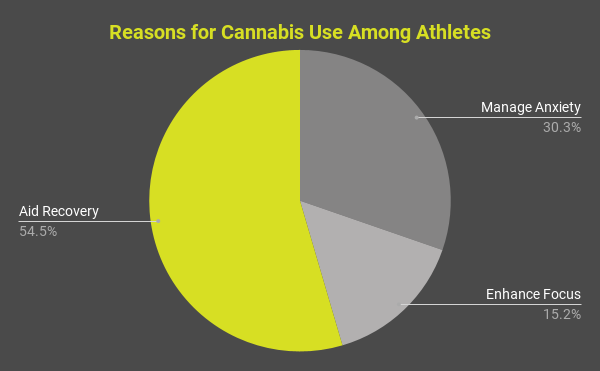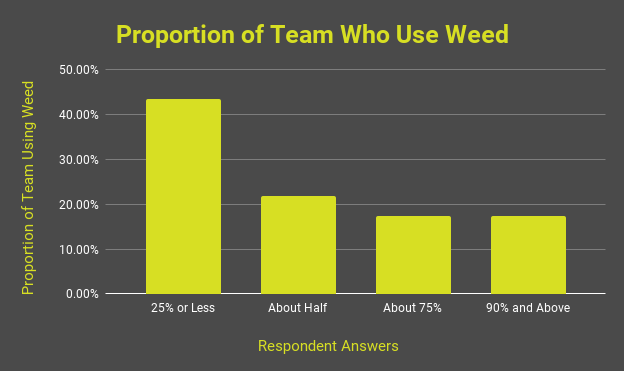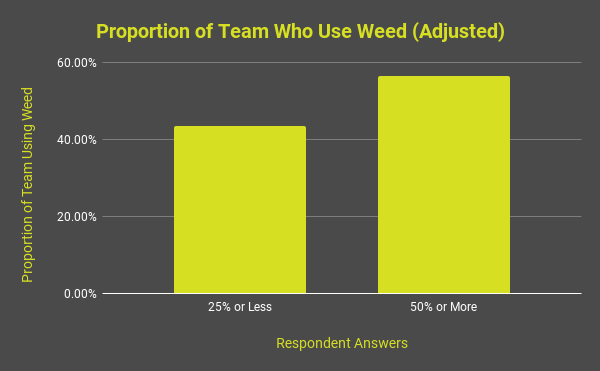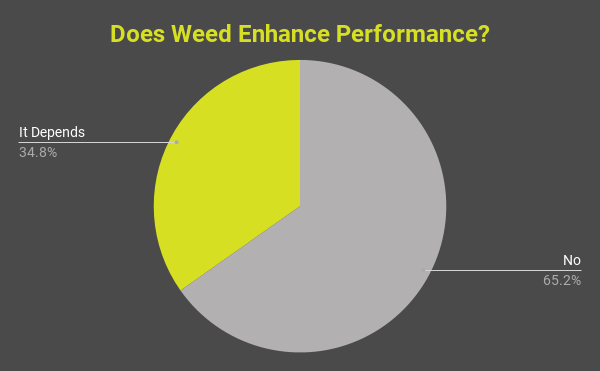Why Competitive Athletes Smoke Weed
Collegiate and professional athletes who are caught smoking or using weed face harsh criticism and punishment. That’s why most keep their cannabis habits private while their careers are in motion. If the league catches them, their reputations become stained, and their future livelihoods are put at risk.
When the NCAA catches college athletes smoking using THC, their candidacy for professional teams suffers. Teams see them as risky, which diminishes starting salaries and can prevent their chances of being drafted.
When professional athletes are caught, they are charged with fines, see smaller numbers on future contracts, and lose current and future sponsorship deals– as we’ve seen with Michael Phelps.
Though most available research finds that weed could act as a substitute for addictive prescription drugs like sleeping pills, barbiturates, and opioids, cannabis remains on the NCAA banned substances list. This list is essentially the same for all leagues and follows the World Anti-Doping Agency’s (WADA) guidelines.
Prohibition and the punishments for violating it force athletes who suffer from injury, insomnia, anxiety, and depression to decide what is more important: their future income or their future well-being.
We believe that most league rules on cannabis are outdated, guided by the historically negative association that the war on drugs has perpetuated for decades. Though many are hopeful that change will come with federal legalization, we might be waiting ten more years for national legislation at the current rate. We can’t wait that long.
The careers of too many athletes have already suffered far too much. Too many reputations have been irreparably stained from the use of the plant, and too many athletes have grown addicted to prescription drugs in the absence of alternatives.
We need to conduct more research to validate cannabis as a prescription substitute that does not pose more of a health risk than alcohol and tobacco, two substances that sports organizations tolerate despite conclusive evidence of their health risks.
And that is the intention of this study: to contribute to the growing body of research on cannabis in competitive sports and to spur further studies surrounding weed’s effect on athletes and athletic performance.
In what follows, we discuss the structure, methods, and limitations of our survey before discussing the results and their context within prior research and current events.
Summary of Findings
- Most of the stoner athletes surveyed for this study used cannabis to aid recovery. 30.30% of athletes smoke weed for anxiety relief, and 15.15% got high to improve focus. Almost half of the respondents only used weed after practice and games were complete, while 43.48% got high both before and after practice and games. However, some noted that their weed use was separate from their athletics schedule; these athletes would have used weed at the same rate regardless.
- Most respondents noted that 50% or more of their team used weed, while 43.48% said that between 0 and 25% of their team used weed. When asked whether they thought of weed as a performance enhancer, none of the participants said yes. They either said that weed does not enhance performance or that it can sometimes enhance performance for specific individuals when used in low doses to combat certain issues that hinder performance (like anxiety).
- A massive amount (78.95%) of respondents knew at least one player on their team who used prescription drugs. 40.91% of athletes had been in trouble with their league, athletic department, or coaches for smoking cannabis.
Methods
Purpose of Study
We conducted this survey to investigate the use and impact of cannabis among athletes who smoked weed while playing competitive sports at the college and/or professional levels.
Specifically, we sought to explore how and why athletes used cannabis; whether non-user athletes turned to prescription drugs as weed alternatives; the quantity of athletes using weed on various teams; whether usage positively or negatively impacted performance; and the impact of drug testing protocols on usage and athlete mentality.
Participants
Our data represents responses from 25 stoner athletes who smoked or used cannabis while playing competitive sports in college. Though some athletes preferred edibles, most athletes smoked weed because of supply limitations. We contacted them via direct outreach utilizing WaxNax’s broad athlete network.
To encourage honesty in responses, we left the respondent name field optional and did not request school name. To further promote openness, respondents only qualified if they had since graduated and no longer competed in college sports.
Limitations
This study carries several limitations, including: the participants are not representative of a broad range of sports; the number of respondents playing each sport is unequal; the respondents played at a range of divisions that differ in competitiveness and league drug testing protocol; and the group is solely composed of people in our communal WaxNax network, which means the study lacks randomization. We would also like to have seen a greater quantity of respondents in general.
We did not request demographic information on race, gender, or age, which may have shed light on the progress of NCAA testing through the years and differences in consumption habits between race and gender. However, since we contacted respondents via direct outreach, we are confident that most respondents are between the ages of 23 and 30, with a few outliers at around 40 years old.
Survey Structure
One should note that many of our survey questions were written in the form of direct responses, which we have aggregated to create data points. For example, one open-ended question asked respondents to portray their weed routine on practice and game days. All respondents indicated whether they used THC before practice and games and whether they used it after. To create data points for analysis, we separated the responses into three categories:
- Uses weed primarily before practice and games;
- Only uses weed after games;
- Uses weed before and after games and practice.
We used this data aggregation method to analyze several survey questions.
Though this method made data analysis more troublesome, it allowed us to garner respondent sentiment and acquire a deeper understanding of each individual’s weed usage– much of which we will discuss in our next blog. As such, the survey’s open-ended nature has furthered the notion that the benefits of weed usage on performance and recovery vary according to the individual.
Results
Population
Of the 25 former college athletes comprising this survey, 11 played lacrosse, 9 played baseball, 2 played volleyball, 1 played football, and 1 played water polo. Of those, 4 athletes went on to play professionally, 2 were baseball players, and 2 were lacrosse players.
Since lacrosse and baseball players make up the most significant proportion of respondents, we will sometimes compare results between these two groups in the proceeding analysis. This method will also help us analyze usage variance between contact sports (lacrosse) and non-contact sports (baseball). Likewise, it will help us analyze the differences between high-cardio sports (lacrosse) and low-cardio sports (baseball).
Reasons for Weed Use

When we asked stoner athletes why they used weed, most respondents (54.55%) said they used THC to help with recovery. 30.30% got high to cope with anxiety, while 15.15% did so to improve their focus on the field.
These results contrast with a 2001 NCAA study that found that only 0.6% of athletes used cannabis to enhance performance. The variance is likely due to the difference between the prior survey’s criteria for respondent qualification and those of our survey. The preceding study surveyed current college athletes regardless of whether they had used weed. Another explanation might be the advances in legislation and social acceptance of cannabis that have occurred since 2001. Though the survey was anonymous, current athletes might have been wary of potential backlash from their responses, which may have encouraged dishonesty.
A few respondents noted that whether or not they used cannabis did not depend on whether they were playing or competing that day. As such, it seems that true stoner athletes are so accustomed to playing sports while high that they might perform worse when not high.
Notably, recovery was the reason most frequently cited for athlete weed use. People have used cannabis to treat pain since almost 3000 BC, and many researchers have found conclusive evidence that it aids in pain management.
Despite this, most sports organizations ban cannabis. Weed is listed on the NCAA banned substance list and many others, while alcohol and tobacco are not.
Many former NFL football players are advocating for legalization, noting that it might help combat the chronic pain and opioid addiction plaguing retired football players.
Somewhat spurred by their advocacy, the NFL recently donated money to study the effects of cannabis in injury recovery. To avoid complicating the league’s testing protocol, they are partnering with the professional rugby league for the study.
When do Athletes Use Weed?
When asked when they used cannabis, most stoner athletes (47.83%) said they only used weed after practices and games. 43.48% of respondents said they used weed before and after games and practices, while only 8.69% used cannabis primarily before games and practices.
The low amount of athletes who smoke weed primarily before games align with prior findings that weed can improve performance for athletes who struggle with anxiety on the field when taken in low doses.
A more significant proportion of lacrosse players (50%) used weed before and after games and practice than baseball players (33.33%). None of the surveyed baseball and lacrosse players used weed only before playing their sports. 50% of lacrosse players only got high after they completed games and practice, while a more significant proportion (66.67%) of baseball players used weed only after games and practice.
These differences could indicate one of three things. Baseball could require a higher degree of focus and reaction time for the average player; a greater proportion of the surveyed lacrosse players competed in less competitive divisions than the baseball players; or lacrosse could have a more accepting culture surrounding cannabis. Further studies are certainly needed.
Prescription Drug Use On NCAA Teams
We also sought to investigate the occurrence of athletes using prescription drugs and whether athletes used prescription drugs as weed alternatives.
78.95% of respondents noted that they knew at least one player on their team who used prescription drugs (e.g. Adderall, opiates, barbiturates). However, it is unclear whether they were doing so as a substitute for weed, for verifiable health reasons, or because the weed alternative provided more beneficial performance outcomes than weed. Regardless, this is a worrisome statistic.
Further research is certainly needed in this area. Mainly because, according to a recent study of asthma patients, only 40.9% of physicians ever bring up cannabis as a viable treatment alternative with their patients. Though this statistic comes from a study focusing on cannabis as an alternative to asthma treatment rather than as an alternative to medications discussed in our study, it is likely that physicians rarely discuss cannabis as an alternative treatment for other conditions.
Since cannabis is still federally illegal, physicians risk losing their licenses if they recommend it, which deters them from pro-cannabis discussions.
Amount of Weed Users on College Teams

The majority (43.48%) of respondents estimated that between 0 and 25% of their team used weed. 21.74% said that around half of their team used weed. 17.39% said that about three-quarters of their team used weed, and 17.39% said that over 90% of their team used weed.
When viewed in conjunction, the last three statistics are notable. 56.52% of respondents noted that over half of the athletes on their team used cannabis. This is a much higher number than prior studies have indicated.

A 2017 study of 23,000 student-athletes indicated that about 25% of student-athletes had smoked cannabis at least once in their lives. This is a much lower number than our findings. However, considering the difference between using cannabis once per lifetime and being a consistent cannabis user, the variance makes more sense.
It is also possible that some of the athletes surveyed for the 2017 study were not honest in their responses because they were still in attendance when surveyed.
70% of lacrosse players said that over 75% of their team used THC. 44.44% of baseball players noted that more than half of their team used weed, and 55.56% said that between 0 and a quarter of their team used weed.
Some might predict that a low cardio sport like baseball would lead to more players using weed than a high cardio sport like lacrosse. On the other hand, lacrosse is a contact sport with a more frequent occurrence of injury, it may sense that more lacrosse players use weed. They may need more help recovering from injury and dealing with sore muscles. Another explanation could be varying levels of social acceptance of cannabis in differing sports cultures.
Does Weed Enhance Performance?

In responding to whether they believed weed enhances performance, the majority (65.22%) of respondents said that weed should not be considered a performance enhancer. In addition, 34.78% said that whether weed enhances performance depends on the person, their individual needs, and the dosage.
Most notably, none of the respondents indicated that weed should be considered a performance enhancer. Instead, some compared cannabis to steroids and blood doping, noting how these true performance enhancers invariably lead to improved physical performance while the effect of cannabis varies with the individual.
These responses support the NCAA’s recent ruling that cannabis is not a performance-enhancing substance. It also aligns with prior research from four studies that found that cannabis use did not benefit athletic performance and indicated that it might hinder performance.
However, some hypothesize that the euphoric feelings caused by cannabis can have anxiety-relieving properties in competitive settings, which could lead to improved performance for some individuals. For example, I play my best golf when high.
The first time I got high while playing golf, I smoked joints between holes and ended up shooting my personal best score. Normally, I get anxious and nervous about missing a shot, which ends up causing me to overthink and miss-hit the shot. That day, I swung smoothly and never felt the pressure because I was so relaxed and free from anxiety. I’m sure the strain used also impacts performance.
Along these lines, athletes in prior studies cited psychological factors like relaxation and improved sleep quality as benefits of cannabis use; athletes who struggle with sleep may perform better when using weed to improve sleep.
However, cannabis does not seem to directly and consistently impact physical performance.
Getting in Trouble
40.91% of athletes said they had been in trouble with their league, athletic department, or coaches for using weed.
Though the degree of punishment varies according to the disciplinary body, the context, and the league at hand, it is ridiculous that an athlete’s career is at risk simply because of their use of a plant that could be helping them deal with more severe issues. Actually, discouraging athletes from using THC may encourage them to use more accepted and available weed substitutes, like painkillers.
Analyzing NCAA Banned Substances Criteria
The NCAA banned substance list (along with the banned substance lists of most leagues) follows the guidelines established by the World Anti-Doping Agency’s (WADA) criteria for banned substances, almost to a T. WADA qualifies banned substances as those which meet two of the following three criteria:
- It has the potential to enhance or enhances sport performance;
- Use of the substance or method represents an actual or potential health risk to the athlete;
- Use of the substance or method violates the spirit of sport (as described in the introduction to the Code).
Until recently, many worried that THC violated all three of these criteria. However, the NCAA recently disproved the first. Though it can lead to better performance in particular contexts for certain individuals (such as an anxious golf player like me), cannabis does not unequivocally enhance performance. The second and third criteria are still up in the air.
The second criterion is difficult to prove since longitudinal studies on cannabis are absent. However, this criterion bears a paradox. While it is uncertain whether or to what extent cannabis “represents an actual or potential health risk,” the use of tobacco and alcohol is not banned despite conclusive evidence of their health risks. Perhaps this is because they only meet the second criteria, not the first or second.
This leads us to the third criterion, often referred to as the “Spirit of Sport Rule,” which is difficult to discern because it is not clearly defined. The WADA Code describes the spirit of sport as “the ethical pursuit of human excellence through the dedicated perfection of each Athlete’s natural talents.” One can glean more understanding through Article 18 of the WADA code on education, which states that “education programs shall promote the spirit of sport and have a positive and long-term influence on the choices made by Athletes and other Persons.”
In this context, the Spirit of Sport Rule seems to note the status of student-athletes as celebrities and places them on a pedestal. They are expected to act as role models who embody everything that competitive sport seeks to represent; to act as ethical, honest, selfless people who are looked up to by all aspiring athletes and the general community. Perhaps this is because they are often seen as ambassadors or embodiments of the universities they attend.
As such, it seems that the historically illegal status of cannabis weighs in on its inclusion on the banned substance list. Since cannabis carries a potential for abuse in specific contexts, and since many have purported that it could lead to the use of more heavy drugs, weed may violate values like long-term health and the respect for rules and laws which the Spirit of Sport Rule infers.
However, it is notable that the NCAA recently decreased punishments for cannabis. But, athletes who fail two or three drug tests may still lose eligibility. Furthermore, the NCAA’s new protocol for dealing with athletes who smoke and test positive for cannabis is flawed.
It says that athletes who fail for cannabis must adhere to a university-established management and education plan. If the athlete is not compliant with the plan, they may lose eligibility. However, the NCAA does not provide additional guidance on what should be involved in this plan.
The NCAA seems to infer that academic performance is included in the management plan. What happens if the athlete is already a high-performing student while using THC? If one was an A- student, would they be expected to raise their average grade to a solid A as part of this management plan? What if an athlete takes weed to cope with insomnia and performs poorly in school and on the field when forced to stop using his medication? Things are certainly unclear.
Concluding Thoughts
What we find most ridiculous is that cannabis has an undeniable potential to benefit athletes on and off the field, acting as a substitute for more harmful substances that are readily prescribed for pain, anxiety, depression, and sleep.
Athletes are celebrities. If they mess up a big play during a big game, the media takes hold. In addition to losing future deals, they are put on the front page of Sports Center, receive hate mail on Twitter, and could become a meme. The pressure is overwhelming. It can lead to sleepless nights, heightened anxiety, and depression– all of which could be treated with cannabis, if it wasn’t prohibited.
Have a nice read? Sign up for the WaxNax newsletter below to get our blog sent directly to your inbox, along with exclusive discounts, deals, and event invitations.


